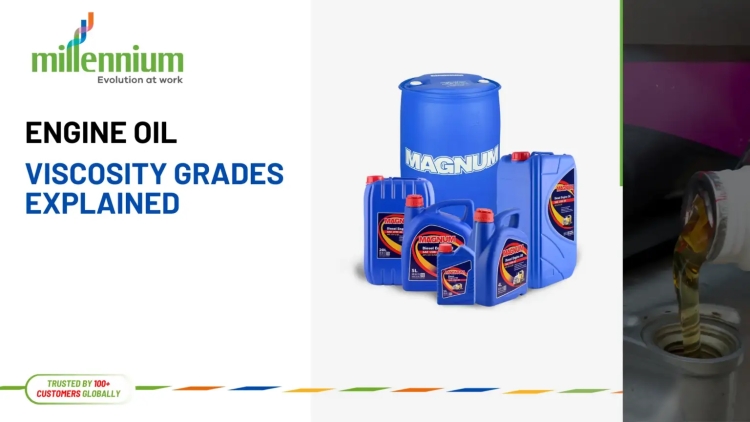Engine oil viscosity grades explained
Understanding engine oil viscosity grades empowers vehicle owners to make informed decisions, ensuring their engines run smoothly and efficiently.

Engine oil is a vital component in maintaining the health and performance of a vehicle’s engine. Among its many properties, viscosity is a key factor that determines its ability to lubricate, protect, and ensure optimal engine function under various conditions. Understanding engine oil viscosity grades is essential for selecting the right oil for your vehicle and ensuring its longevity.
What is Engine Oil Viscosity?
Viscosity refers to a fluid’s resistance to flow. In the context of engine oil, it describes how easily the oil flows through the engine’s components at different temperatures. A low-viscosity oil flows more readily, making it suitable for cold starts, while high-viscosity oil offers better protection at higher temperatures. The right balance ensures smooth engine operation and reduces wear and tear.
Viscosity Grades and What They Mean
Viscosity grades are standardized measurements established by the Society of Automotive Engineers (SAE). These grades indicate the oil’s performance at specific temperatures. For instance, grades like 5w30 vs 10w30 oil represent a range of viscosities suitable for different operating conditions. The “W” stands for winter, denoting the oil’s performance in cold conditions, while the numbers before and after the “W” signify its viscosity at low and high temperatures, respectively.
The Role of Temperature in Oil Viscosity
Temperature significantly affects engine oil viscosity. During cold starts, the oil must flow quickly to protect engine components, while at operating temperatures, it needs to maintain a protective film to prevent metal-to-metal contact. Oils that fail to adapt to temperature changes can cause engine inefficiencies, increased wear, and potential damage. This is why multi-grade oils, capable of performing well across a wide temperature range, are commonly used.
Common Viscosity Grades
Some of the most commonly used viscosity grades include:
-
5W-30: Ideal for modern engines, offering excellent performance in both cold starts and high operating temperatures.
-
10W-40: A versatile grade suitable for older engines or those operating in moderate climates.
-
0W-20: Preferred for fuel-efficient engines, providing low viscosity for reduced friction.
-
15W-50: Commonly used in high-performance or heavy-duty engines, offering robust protection under extreme conditions.
What Do the Numbers Mean?
The numbers in oil viscosity grades provide a clear picture of the oil’s characteristics:
-
First Number (Before “W”): Indicates the oil’s viscosity in cold conditions. Lower numbers signify better flow at low temperatures, ensuring easier starts in winter.
-
Second Number (After “W”): Represents the oil’s viscosity at high operating temperatures. Higher numbers mean the oil maintains its thickness under heat, providing better protection.
Multi-Grade vs. Single-Grade Oil
Multi-grade oils are designed to perform efficiently across a range of temperatures, making them the go-to choice for most modern vehicles. Single-grade oils, on the other hand, have a fixed viscosity and are typically used in specialized applications or older engines. For example:
-
Multi-Grade Oil (e.g., 5W-30): Offers adaptability for both winter and summer conditions.
-
Single-Grade Oil (e.g., SAE 30): Provides consistent viscosity but is limited to specific temperature ranges.
How to Choose the Right Oil Viscosity
Selecting the right oil viscosity involves considering factors such as your vehicle’s manufacturer recommendations, local climate, and engine type. Here are some tips:
-
Check the Owner’s Manual: Follow the manufacturer’s specifications for optimal performance.
-
Consider Climate: Use low-viscosity oils in colder regions and higher-viscosity oils in warmer climates.
-
Engine Age and Condition: Older engines may benefit from higher-viscosity oils that provide better sealing and protection.
-
Driving Conditions: For heavy loads or frequent high-speed driving, opt for oils with robust high-temperature protection.
Viscosity Index and Its Importance
The viscosity index (VI) is a measure of how much an oil’s viscosity changes with temperature. A higher VI indicates better stability across temperature ranges, ensuring consistent performance. Modern oils with high VI additives are designed to maintain optimal lubrication in both extreme cold and heat, making them suitable for diverse driving conditions.
Beyond Viscosity: Other Considerations
While viscosity is a critical factor, other properties like oil type (conventional, synthetic, or blended), detergent additives, and anti-wear agents also play a role in engine performance. Synthetic oils, for instance, often offer superior viscosity stability, better protection, and extended service life compared to conventional oils.
Conclusion
Understanding engine oil viscosity grades empowers vehicle owners to make informed decisions, ensuring their engines run smoothly and efficiently. By choosing the right viscosity grade for your specific needs, you can enhance engine performance, reduce wear, and extend the life of your vehicle. Whether you’re a daily commuter or a performance enthusiast, the right oil makes all the difference.
What's Your Reaction?





















